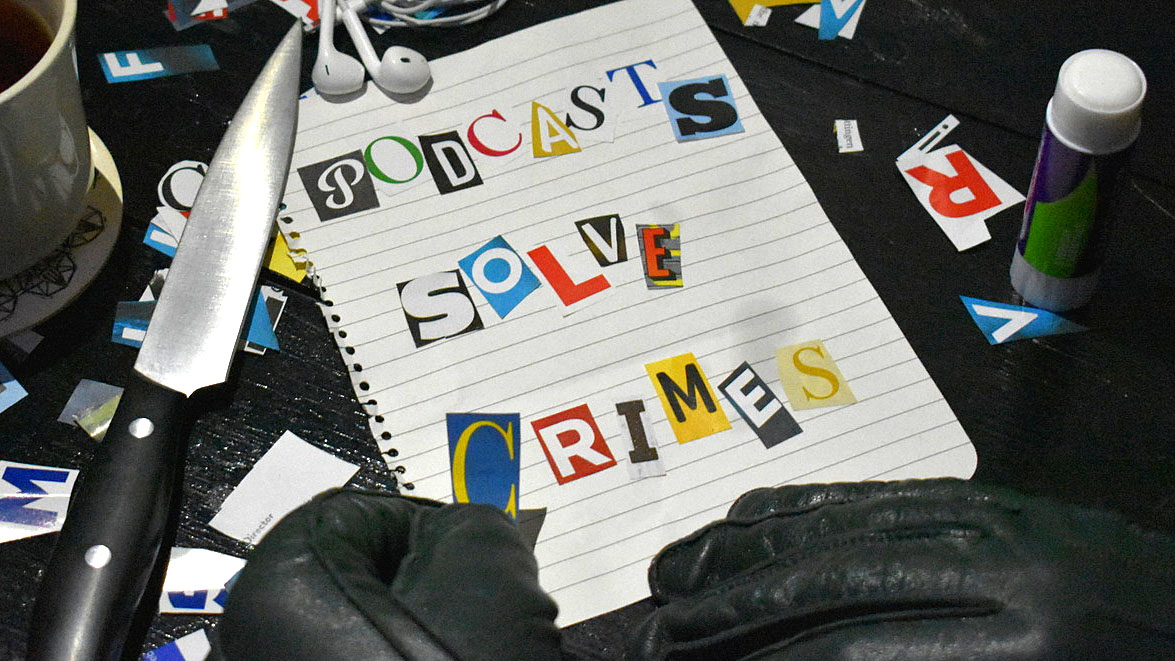Listen Up: podcasts are solving crimes

caption
Photo illustration.First there were milk carton kids. Now there’s Serial.
In 2001, police dug up a slashed cardigan on a Sydney, Australia property where mother, wife and nurse Lyn Dawson vanished in 1982. Journalist Hedley Thomas, working for the Courier-Mail, wrote a feature on the case and the story haunted him for the next decade. The property was excavated again last month, 36 years after Dawson’s disappearance, thanks to Thomas’s podcast.
“When I covered it back then I just thought it was such a riveting story of injustice, tragedy and missed opportunity,” says Thomas. “And possible police corruption.”
The Teacher’s Pet, released in May 2018, is an investigative podcast produced by The Australian newspaper and hosted by Thomas, their national chief correspondent. The podcast has been topping Australia’s iTunes chart for months.
Disappearances, unsolved murders and cold cases have always mystified people, journalists especially. Podcasts have become a crusade in the true crime genre, with journalists using them as tools to glue together the pieces of puzzles, hoping listeners will engage and search for the missing pieces between episodes. Serial, hosted by journalist Sarah Koenig and produced by This American Life, debuted on iTunes and other streaming networks in 2014, with a fresh eye examining the murder of Maryland high school student Hae Min Lee.
The podcast caused a divergence of listener opinions; eventually the conversation reached the courts, granting the accused murderer a re-trial. Serial is the most listened to podcast in history, having been downloaded a whopping 250 million times.
We’ve seen it recently in Netflix’s docuseries Making a Murderer and Michelle McNamara’s book I’ll Be Gone in the Dark. Journalism and true crime are coming together and getting results.

caption
A person listens to the Serial Podcast.Old wounds
Having not done so much as touch her bank account, Lyn is presumed dead. Her husband Chris, a rugby star turned gym teacher, has always been the only murder suspect. Now 70, he has always maintained his innocence.
He was sleeping with his 17-year-old student and babysitter, Joanne Curtis, who moved in two days after Lyn’s disappearance. Reportedly he abused Lyn but was extremely close with his twin brother Paul. Chris’s private life would become the Gordian Knot of Thomas’ investigation.
“This is a very blokey mazy culture of rugby league stars,” Thomas says. “As the Dawson boys were certainly very popular and successful footballers, I think the police wanted to help them where they could.”
Initially, Chris was not an important suspect. Thomas found there was a police detective, a rugby fanatic detective who favored the Dawson twins, advising Chris. Later, suspiciously, case files went missing, one containing Chris’s original statement.
“In that statement, he made a number of false claims. And he also wrote down very important facts, including that he was in a relationship with a schoolgirl at the time his wife disappeared.”
Trickling from these findings, Thomas’ podcast reveals that other teachers at Chris’s school were having sex with underage girls. That investigation is also ongoing.
While nothing was found during a police dig last month, Thomas says now that police are doing their part. Justice for Lyn, he believes, “will eventually happen in time.”
Podcasts are convenient to binge. Whether you are doing the dishes or walking the dog, they are a multitasker’s gold.
Ryerson University news production specialist Angela Glover says it’s the “emotional reaction” that makes podcasts so appealing. When it comes to true crime, she says, there needs to be “tension.”
“It’s the same kind of idea as telling stories around a campfire,” she says. “Especially with cold cases – it has that creepy element.”
A 2010 study found that 56% of podcast listeners are male, and 44% are female. Since then, other studies have shown that the true crime audience majority are women. The reason, the studies say, is that women fear the heinous rapes and serial murders that are more likely to happen to them. To understand their fear, they face it.
There is even a podcast based on this very premise: My Favorite Murder, hosted by comedians Karen Kilgariff and Georgia Hardstark.
Amanda Vicary, an assistant professor of psychology at Illinois Wesleyan University, told Business Insider in an article that women often turn to true crime as a “guidebook for what can happen to them.”
Killer connections
Beauty queen and 30-year-old school teacher Tara Grinstead went missing in her small town of Ocilla, Georgia in October 2005. Her disappearance was ice cold by the time Atlanta filmmaker Payne Lindsey decided to research her case eleven years later. Lindsey posts a question on the forum Websleuths, and less than an hour later, got a reply. “If that contact between Payne and I had not happened, this case would not be solved,” says forensic investigator Dr. Maurice Godwin, who appears on Lindsey’s podcast Up and Vanished.
Godwin knew more about the case than anyone, having been hired by the Grinstead family in 2006. The pair exchanged phone numbers, and on their first call talked for hours.
Up and Vanished is an anomaly, with none of the production team having any previous journalism or legal experience. Two years and 150 million downloads later it was the first podcast to lead to arrests.
Up and Vanished producer Donald Albright met Lindsey on the set of a music video. The pair exchanged their visions and found a mutual interest: true crime. They formed a multimedia company, Tenderfoot TV, which today also manages Atlanta Monster and Sworn podcasts. Atlanta Monster investigates the Atlanta Child Murders occurring between 1979 and 1981, while Sworn tells untold stories behind major cases passing through the criminal justice system.
Had they made Up and Vanished a TV series, Albright says, it would not have had as much impact. “If we were here and gone, it wouldn’t have had the time to build, infiltrate a town and stir things up. There is always a natural sort of intrigue in finding out what happened to a person, or how this crime happened.”
Ocilla, with a population of just 3,286, became home for the team throughout the entire investigation and first season. Townspeople wore patience like an over-washed shirt. They wouldn’t talk… at first. When they finally did, the filmmakers wouldn’t always get information. Instead, sometimes, they got threats. Eventually, the pressure the investigation put on the town compelled people to come forward.
In February 2017, five months after Up and Vanished was released, and after twelve years with no new leads, a tip was called in to police. One of Grinstead’s former students, Ryan Duke, was arrested and charged with murder. In June 2017 his brother, Bo Duke, was charged with concealing a body.
Albright says he and Lindsey never set out to solve the crime. “It’s the hope, it’s not the goal.”
Educating the masses
Not all disappearances lead to murder, and sometimes the crime isn’t committed by an individual, but by a nation.
CBC journalist Connie Walker’s two-season podcast Missing and Murdered examines the lives of two Indigenous women, Alberta Williams and Cleo Semaganis Nicotine. “Our Podcast is called Missing and Murdered, but I don’t really think of it as a typical true crime podcast,” says Walker.
Missing and Murdered: Finding Cleo is another podcast that solves a disappearance and debunks a murder myth. The ten-episode investigation finds out what happened to Cleo after she was separated from her siblings during the Sixties Scoop.
The family understood that she was adopted in the U.S., tried to hitchhike back, but was raped, killed and left to die. With the help and love of Cleo’s siblings, Walker found out that this story was not true. What they found was a different devastating story, with a death by suicide.
In Walker’s podcast are lessons that were left out of Canadian history classes.
“We’re using this one story to help tell the bigger story of the reality of life for Indigenous people in Canada today,” says Walker, “but also our shared history for over the last 150 years.”
Deadly entertainment
There is something both compelling and aversive about discussing your theory of who killed JonBenet Ramsay.
The popularity of true crime podcasts has inspired groups to discuss cold cases in forums, and on social media platforms like Facebook, Twitter and Reddit. With the endless evidence at your fingertips, anyone can try to be their own investigative journalist, their own detective.
The biggest issue with this is the lack of concern, says Up and Vanished’s Albright. It’s important to be responsible when it comes to naming names and pointing fingers. When deep in a case, “we can all get a little overzealous,” he says. The point is to research the available information, looking for a lead that may have been overlooked.
“If you dig through all of that,” Albright said, “you can find some witness, some piece of evidence, some theory that may pan out to be true.”
Editor's Note
On December 5, 2018, Australian police arrested Chris Dawson in the murder of his wife Lyn Dawson, who went missing in 1982. Their story was told in the popular podcast The Teacher's Pet. Police said the podcast uncovered previously unknown information.

